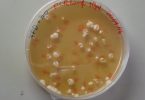In order to exploit the potential benefits associated with cannabis constituents, it is possible to extract them from the plant matrix through various methods involving both solvent or solventless processes. The term cannabis “concentrate” refers to the full spectrum extract, usually with high THC content, that is in the form of a powder or a sticky, honey-like mass and lacking the solvent excess. Certain kind of cannabis concentrates can have from 40% to 90% tetrahydrocannabinol (THC) or cannabidiol (CBD) content. [1] Depending on the used technique or the kind of solvent, many different extracts or concentrates can be produced, differing in appearance and chemical composition. Live resin, rosin, hash oil, moon rocks, shatter, badder, wax, cannabis flower essential oil are just few examples among the long list of extracts or concentrates that can be produced from cannabis plants. The more the manufacturing technique exploits low operating temperatures the better the aroma and taste of the product, because of the reduced terpene profiles degradation. [2]
Solvent-based extracts can be further refined through distillation and concentrated in order to create a product with increased final cannabinoid content, thus enhanced potency. The solvents generally used for this kind of preparations are ethanol, butane, hexane, propane or carbon dioxide at the supercritical state among others. Because of the high flammability and toxicity of certain solvents or the expensive closed loop systems used for supercritical fluid extraction, green extraction approaches attained interest as alternative methods to produce high quality cannabis products. The rosin press is an example of machinery exploiting just heat and pressure to melt out of the plant matter all the cannabis constituents including cannabinoids and terpenes. The composition of the final rosin concentrate doesn’t include traces of harsh chemicals and residual of solvents, making this product particularly safe and easy to make.
Another example of solventless concentrate is the hash formed through mechanical thricome removal that can be facilitated by ice cold water treatment.
Because of the high quantity of active constituents in cannabis concentrates including often high percentages of THC, it is always recommended to start with low dosages and increase progressively the amount taken in order to avoid unwanted side effects and monitoring the response of our body to the product.
References:
[1] NIDA. 2020, Cannabis (Marijuana) Concentrates DrugFacts. Retrieved from https://nida.nih.gov/cannabis: a narrative review. J Cannabis Res. 2021 Jul 19;3(1):32. doi: 10.1186/s42238-021-00087-9. PMID:
34281626; PMCID: PMC8290527.








